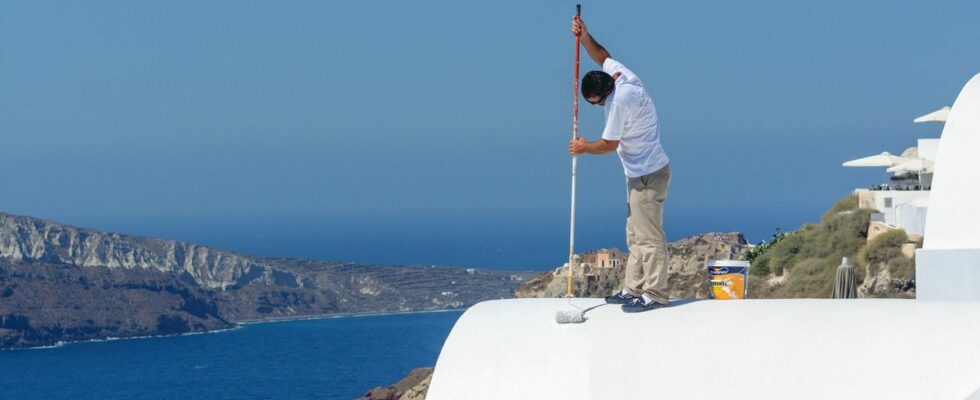Published on
Updated
Reading 3 min.
A technique tested in several cities, repainting roofs and structures in white is often presented as an effective remedy against urban heat waves. Two recent studies confirm the beneficial effect of this solution, which could reduce the surrounding temperature by up to 2 degrees.
In any case, white paint would be more effective than other alternatives such as solar panels, which placed on roofs create shade and on the ground absorb solar radiation, or vegetation, according to scientists from University College London (UCL).
Their study published Thursday in Geophysical Research Letters was conducted using three-dimensional climate modelling of the Greater London metropolitan area using data from the summer of 2018, the hottest ever recorded in the British capital.
It shows that “if they were implemented on a large scale throughout London“, cooling roofs painted in white or reflective material (also called “cool roofs”), can “reduce the outside temperature in the city by an average of 1.2 degrees and up to two degrees in some places“.
““Cool roofs are the best solution to keep the temperature down on the most extreme summer days. Other methods have additional benefits, but none of them can reduce the heat in a comparable way.”explains Dr. Oscar Brousse, lead author of the study.
Better than greening
Solar panels or greening the streets would only lower the thermometer by 0.3 degrees on average.
Similarly, green roofs, apart from their difficulties of implementation (necessary load-bearing capacity for the additional weight they represent) and despite their benefits for drainage of bad weather or biodiversity, would only have a “negligible effect” for cooling, affirm the authors of the study.
Finally, air conditioning, by transferring heat from inside buildings to outside, would warm the city as a whole by 0.15 degrees, but up to +1 degree in central London, contributing to the formation of heat islands.
“By reflecting heat rather than absorbing it, cool roofs have the dual benefit of reducing the temperature not only in the outdoor urban environment but also inside buildings.“, the study emphasizes.
Repaint everything?
Another study from March, this time conducted in real conditions in a Singapore neighborhood where the roofs, walls and road surfaces had been repainted white, showed that the overall temperature could be reduced by up to 2 degrees in the afternoon, and that the thermal comfort felt by passers-by was improved by up to 1.5 degrees.
This is due to the “albedo effect”, according to which the lighter a surface is, the more light it reflects, and therefore heat. A white thermoplastic roof, for example, can reflect 80% of the sun’s rays.
These methods, recommended by the IPCC and already practiced in several Mediterranean countries, such as Greece, are being tested in different cities in countries that were once temperate but are increasingly regularly subject to heat waves.
So could all-white cities be the solution to the heat?
It depends. For those who have chosen to cover buildings and floor coverings in an immaculate color, the results appear mixed.
In Los Angeles, for example, which repainted part of its sidewalks white in 2017, passers-by complained of a greater feeling of stuffiness – the heat was only reduced at ground level and not at human height – and of the dazzling effect of the white.
Lyon also ended a two-year trial of white street coverings in August, deeming them too expensive and too dirty.
Conversely, when it is used only on the roofs of buildings, the experiment proves conclusive: in Grenoble, after having repainted the Bifurk, an association hall, in white, the city is enthusiastic about the results, -4 degrees according to an independent study.
In Tremblay-en-France, the Jean-Guimier gymnasium, which will serve as a training center for the Paris 2024 Olympic Games, has gained 5 degrees of freshness after having its roof immaculate.
